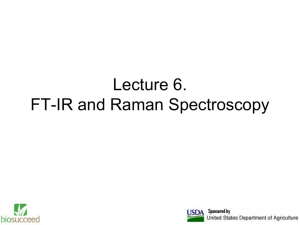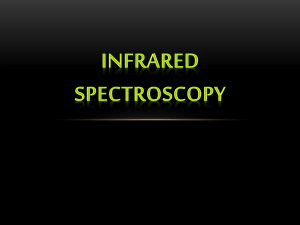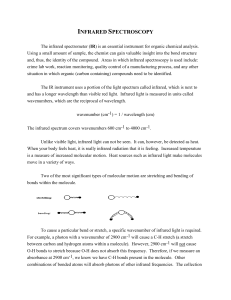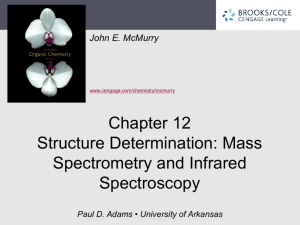III. FAR INFRARED SPECTROSCOPY C.
advertisement
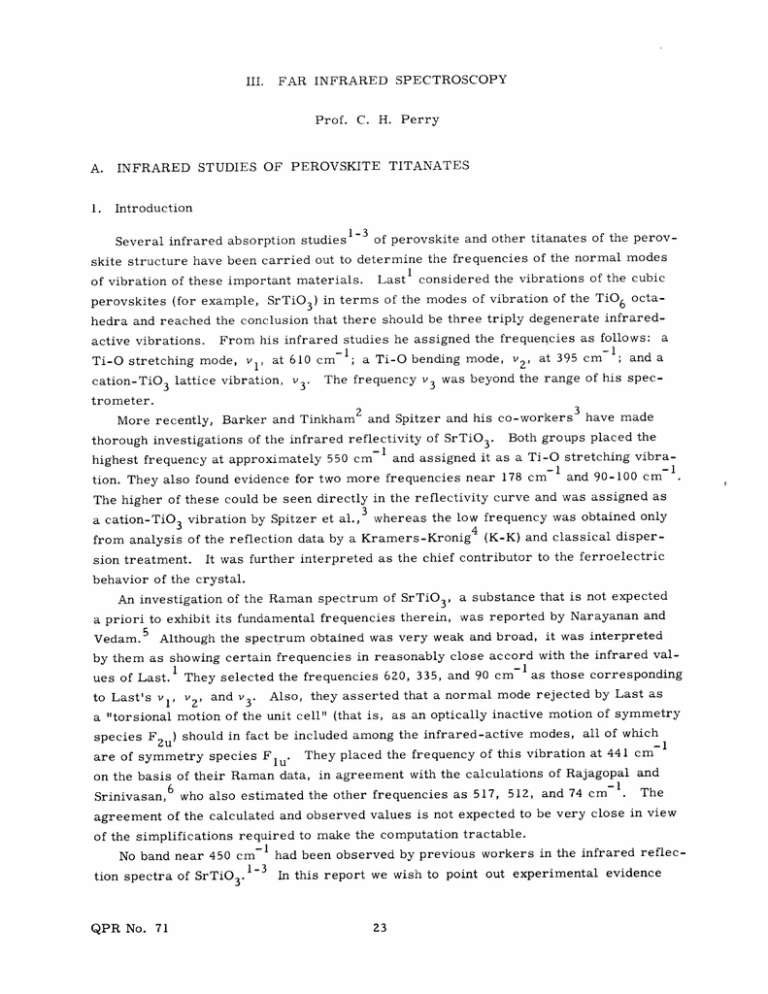
III. FAR INFRARED SPECTROSCOPY Prof. C. H. Perry A. INFRARED STUDIES OF PEROVSKITE TITANATES 1. Introduction Several infrared absorption studies1-3 of perovskite and other titanates of the perovskite structure have been carried out to determine the frequencies of the normal modes of vibration of these important materials. Last 1 considered the vibrations of the cubic SrTiO 3 ) in terms of the modes of vibration of the TiO 6 octa- perovskites (for example, hedra and reached the conclusion that there should be three triply degenerate infraredactive vibrations. From his infrared studies he assigned the frequecies as follows: a Ti-O stretching mode, v 1 , at 610 cm1 ; a Ti-O bending mode, cation-TiO 3 lattice vibration, v3 . v 2 , at 395 cm1 ; and a The frequency v 3 was beyond the range of his spec- trometer. More recently, Barker and Tinkham 2 and Spitzer and his co-workers 3 have made of SrTiO 3 . Both groups placed the thorough investigations of the infrared reflectivity -1 highest frequency at approximately 550 cm-1 and assigned it as a Ti-O stretching vibra-1 -1 and 90-100 cm tion. They also found evidence for two more frequencies near 178 cm The higher of these could be seen directly in the reflectivity curve and was assigned as a cation-TiO 3 vibration by Spitzer et al.,3 whereas the low frequency was obtained only 4 from analysis of the reflection data by a Kramers-Kronig (K-K) and classical dispersion treatment. It was further interpreted as the chief contributor to the ferroelectric behavior of the crystal. An investigation of the Raman spectrum of SrTiO3 , a substance that is not expected a priori to exhibit its fundamental frequencies therein, was reported by Narayanan and Vedam.5 Although the spectrum obtained was very weak and broad, it was interpreted by them as showing certain frequencies in reasonably close accord with the infrared val- 1 1 as those corresponding ues of Last. They selected the frequencies 620, 335, and 90 cm Also, they asserted that a normal mode rejected by Last as to Last's v 1 , v 2 , and v 3 . a "torsional motion of the unit cell" (that is, as an optically inactive motion of symmetry species F 2 u) should in fact be included among the infrared-active modes, all of which -1 are of symmetry species Flu. They placed the frequency of this vibration at 441 cm on the basis of 6their Raman data, in agreement with the calculations of Rajagopal and -1 r a The Srinivasan, 6 who also estimated the other frequencies as 517, 512, and 74 cm. agreement of the calculated and observed values is not expected to be very close in view to make the computation tractable. of the simplifications required -1 No band near 450 cm-1 had been observed by previous workers in the infrared reflection spectra of SrTiO. 3 QPR No. 71 1- 3 In this report we wish to point out experimental evidence (III. FAR INFRARED SPECTROSCOPY) -i. for the nonexistence of a band at ~450 cm-1 in SrTiO3, but additional bands of varying intensity are present in CaTiO 3 and in PbTiO3 . 2. Experiment The room-temperature reflectances of calcium, strontium, and lead titanates have been measured from 4000 cm--1 to 30 cm -l relative to the reflectance of a reference mirror coated with aluminum. Transmission measurements over the same frequency range were made on finely divided powders of the three materials suspended in polyethylene and potassium bromide matrices. -1 Reflection and transmission data above 300 cm-1 were obtained on a Perkin-Elmer Model 112 double-pass instrument equipped with NaCl and CsBr prisms. The reflection spectra were recorded at an angle of incidence of approximately 45' on the sample. The transmission data were repeated on a Perkin-Elmer Model 521 double-beam spectrophotometer that scanned continuously from 4000 to 250 cm - l . A reflection attachment that provided an angle of incidence of approximately 15' and required a sample of only 18 X 2 mm area was used in the Perkin-Elmer 521 instrument to repeat the reflection -l data down to 250 cm-1 A single-beam grating instrument originally constructed in this Laboratory by Lord 7 and McCubbin, and recently modified to a vacuum instrument with more convenient 8 -1 -1 sample optics was used from 500 cm to 30 cm . The angle of incidence was 150 . The two Perkin-Elmer instruments were flushed with evaporated liquid nitrogen to remove water vapor as much as possible. The complete removal of water vapor in the longwave vacuum instrument provided smooth backgrounds so that more accurate transmission and reflection data could be obtained as compared with those obtained with a flushed instrument. Reflection measurements at 5 cm - l were made on all three materials by using a 2-mm carcinotron as a source at Lincoln Laboratory, M. I. -1 T., and were found to be in good agreement with our far infrared results down to 30 cm-1 The specimen of SrTiO3 consisted of a large, highly polished single crystal, I inch in diameter. Each of the calcium and lead titanate samples was made up of a mosaic of four polycrystalline samples cemented to an aluminum backing plate. The materials were ground and polished to a sample size of 1 X 1. 25 inches so that full use could be made of the light beam with no vignetting. Samples for transmission studies above 300 cm - I were suspended in a KBr pellet by the usual techniques. Below 600 cm-l polyethylene was found to be the most convenient matrix. The temperature of the press was brought up to approximately 120 C, and the samples were pressed at 25, 000 lb/sq in. at this temperature for approximately 5 minutes. QPR No. 71 (III. 3. FAR INFRARED SPECTROSCOPY) Analysis of Data 4 The reflectivity data were transformed by using a Kramers-Kronig relation. The K-K relation used for the reflectivity R can be expressed as (v) = 2v 0T In[r(v')] dv' 2 - v 2 v where 0(v) is the associated phase angle, which was obtained by using the IBM 7090 digital computer. The reflectivity amplitude is characterized by re shown to be a good approximation, i6, where r = R1/2 This has been even at 45".2 = (n-ik-1)/(n-ik+1) re -i 1 - r2 1 + r2 - 2r cos 0 2r sin 0 1 + r - 2r cos 0 k= where n is the refractive index, and k is the extinction coefficient. The real and imaginary parts of the complex dielectric constant, E' and E", can be written E' = n 2 (5) _ k (6) E" = 2nk, and it is more revealing to show the results of the dispersion analysis in terms of the dielectric constant than in terms of n or k. The infinite integral in Eq. 1 was evaluated by representing In r(v') by straight-line The data were extrapolated to cover the infinite interval -1 The reflectivity was assumed constant from 4000 cm-1 to infinity and from segments between data points. of Eq. 1. 30 cm -I to zero. The justification of the extension of the data was confirmed by comparing the limiting values of R predicted from known values of the high- and lowfrequency dielectric constants when these values were known. It is assumed that k << n at these limiting frequencies so that - R = (E1/2 1)2/( I/ 2 + 1) 2 . (7) Each peak in the E" vs energy (frequency) plot provided by the K-K analysis represents a resonance. The frequency of a given resonance is the frequency at which the conductivity o', -j= E' j onance to E". QPR No. 71 9 v/2, is a maximum. 9 The quantity E!' is the contribution of the j j th res- (III. FAR INFRARED SPECTROSCOPY) In the approximation y./v. <<1, the maximum of " also occurs at v where y is given by the frequency halfwidth of the E" peak. 4. Discussion The reflectance and transmittance curves are shown in Figs. III-1 through 111-3. Figures 111-4 through 11-6 show the real and imaginary parts of the dielectric constant -1 for the three materials. Measurements below 400 cm-1 are estimated to be accurate to approximately ±5 per cent for the reasons reported earlier. The reflectance curve shown here for SrTiO 1-3 resembles those reported by the ear- 1 -1 was unable to work below 300 cm and thus was unable to detect -1 the minimum at approximately 175 cm- . Owing to the discrepancy between the results -1 of Last and the other research groups with regard to a band at 400 cm- , we have stud-1 ied carefully the region 500-300 cm- , using both a CsBr prism in the Perkin-Elmer lier workers. Last 3 10 112 and the Perkin-Elmer 521, and a grating of 40 grooves/mm blazed at 360 cm-1 in our long-wave instrument. In the last case we used two reststrahlen plates of CaF 2, which has a very sharp, short-wavelength cutoff at ~20 microns. Reflection measurements over the same range were repeated at two different angles of incidence and also at liquid-nitrogen temperatures. No subsidiary maximum in the -1 region of 450 cm-1 was found before the reflectance curve rose to a maximum at approx-1 imately 360 cmTransmission measurements in this region showed a broad minimum at ~400 cm-1 in agreement with Last1 and with Barker and Tinkham.Z Barker and Tinkham, however, found that this minimum is sensitive to powder density and suggested that it might be a scattering effect. Only in CaTiO 3 and PbTiO 3 was a band observed in reflection around -1 450 cm which had not been reported previously. -1 The curves also show a maximum at approximately 600 cm-1 with a slight shoulder near 700 cm-1 , as well as a low-frequency minimum in reflection around 150-200 cm-1 These results are substantiated by the transmission data, which show minima in the region of reflection maxima and vice versa. curves, As can be seen from the transmittance several different concentrations of the sample were put in KBr and in polyethyl- ene, and no appreciable shift in the frequencies of the minima was observed. -1 . The maximum in reflectance at 605 cm-1 in SrTiO3 is in good agreement with Last, Spitzer and his co-workers, and Barker and Tinkham (before K-K analysis of the data). This band has been assigned to the Ti-O stretching vibration by all of the previous work1-3 ers. But an ambiguity appears to exist as to whether an "internal vibration" or the cation-TiO 3 vibration is responsible for the ferroelectric behavior of these materials below their Curie points. In SrTiO3 the v 3 band has been interpreted as an internal vib- ration, and the v 2 band as the cation-TiO 3 vibration by Spitzer et al., site view is held by others. QPR No. 71 whereas the oppo- 2 A - 0.3 mgcm 60 - B -0.5 gcm 40 I LAST 2 SPITZER TINKHAM 3 THIS WORK Sr TiO 1200 1000 800 600 3 400 200 VAVE NUMBERS (cm- i Infrared transmittance and reflectance spectra Fig. III-1. of SrTiO 3 from3o 1250 to 50 cm-1 A A 0.7 mg cm2 B - 1.4 mg cm C - 1.7 m D - 3 mg cm I PbTi 0 3 I I I O-- of PbTiO3 from 1250 to 5 cm- QPR No. 71 I 60 40 Ca Ti0 3 20 1200 Fig. Fig. III-3. 111-3. 1000 800 40AVE NUMBERS Acm .1 400 600 200 0 Infrared Infrared transmittance and reflectance spectra of CaTiO 3 from 1250 to 5 cm -1 IMAGINARY PART E 600 500 400 300 200 - WAVE NUMBERS (cm Fig. III-4. 100 ) Real and imaginary parts of the dielectric constant of SrTiO3 obtained from the reflectivity data in Fig. III-1. QPR No. 71 40 Pb Ti 03 40 30 20 IMAGINARY PART ,'REAL PART E' I 300 200 0 100 WAVE NUMBERS(cm-1 Fig. III-5. 150 - Real and imaginary parts of the dielectric constant of PbTiO 3 obtained from the reflectivity data in Fig. III-2. CaTiO 3 100 IMAGINARY PART E" 300 200 100 WAVE NUMBERS (cm-1 Fig. III-6. QPR No. 71 Real and imaginary parts of the dielectric constant of CaTiO 3 obtained from the reflectivity data in Fig. III1-3. Table III-1. Modes This work d Last Infrared and Raman frequencies in SrTiO3 (cm-1. 1 Last 1 Tnam 2 Tinkham 3 Spitzer v I (stretch) 555 ±5 610 a 550 v 2 (bend) 185 ±5 395 a -175 no assignment given v 3 (Sr-TiO3 ) 100 ±5 - 100 178 - - v 4 (bend?) -- upprecht 12 Raman (Obs.) using Narayanan Spitzer's Spitzer's results and Vedam 5 Calculated Rajagopal and Srinivasan 6 544 b 544 620 517 8 8b 178 335 512 88 90 74 441 445 aFrequency maximum observed in reflectivity without K-K analysis of the data. bSpitzer does not make it clear whether or not v1 and v 2 should be interchanged. (III. FAR INFRARED SPECTROSCOPY) Table III-1 shows the frequencies of the normal modes for SrTiO 3 reported by previous researchers, and comparison can be made with our results after a K-K analysis of our reflection studies. SrTiO 3 , PbTiO 3 , and CaTiO 3 can be compared with reference to Table III-2. Only -1 observed, and the other additional in CaTiO 3 and PbTiO 3 was a band around 450 cm band in PbTiO 3 also probably arises from systematic distortion from ideal cubic symmetry which would split degenerate modes to give more distinct resonances, the splitting need not necessarily be observed in every case. However, although strains in the crystal could result in the F2u infrared-inactive mode becoming active; possibly this is the reason for an additional frequency in the Raman spectrum of SrTiO 3 reported by 5 Narayanan and Vedam, since their interpretation of four infrared-active modes of Flu symmetry for a cubic crystal appears to be incorrect on the basis of standard group theory. Table 11-2. Frequencies of the normal modes of SrTiO3, PbTiO 3 , and CaTiO 3 obtained from a K-K analysis of the reflection data. Symmetry Point Group SrTiO 3 PbTiO3 Cubic Oh Tetragonal CaTiO 3 Orthorhombic C4v C2 v v 1 (stretch) 555 ±5 v 2 (bend) 185 ±5 V3 (cation- TiO3 ) 100 ±5 (Flu) (Flu 530 ±5 400 549 ±3 (E , A 400 ±5 ) (B 443 ±3 1 BZ A 1) 200 ±3 (Flu) 172 (E u 83 ±2 , A) (Eu, A ) 179 ±2 (B 1 , B 2 , A 1 ) 148 ±2 (B 1, BZ, A 1 ) From Table III-2 it can be seen that in all three titanates the vI and v 2 vibrations are essentially constant as the cation changes from Ca with a mass of 40 to Pb with a mass of 207; however, v 3 depends sensitively on the nature of the cation. It is rea- sonable to associate the properties that remain nearly constant with the TiO 6 octahedron that is almost the same in all three materials. should be vibrations associated with the TiO 6 According to this reasoning, v 1 and v 2 octahedron, whereas v3 should depend on the cation mass (or the reduced mass of the cation and the TiO 6 octahedron), and it appears that the frequency of this vibration is lowered with increasing mass. The authors wish to express thanks to Professor R. C. Lord for his advice and encouragement in this work; to Dr. G. R. Hunt of the Spectroscopy Laboratory, M. I. T., QPR No. 71 FAR INFRARED SPECTROSCOPY) (III. for many helpful discussions of the K-K analysis; and to Mr. J. Ballentyne of the Insulation Laboratory, M. I. T., for the use of his program and for the reflection measurements taken at Lincoln Laboratory, M. I. T. We are much obliged to Dr. G. Wilkinson, King's College, London, for checking our dielectric constant results by using his K-K program on our reflectivity data. We would also like to express our thanks to Dr. G. Rupprecht, Tyco Laboratories, Inc., for supplying the samples. C. H. Perry, B. N. Khanna B. N. Khanna is now at the Indian Institute of Technology, Department of Physics, (Dr. Kanpur (U. P.), India.) References 1. J. T. Last, Phys. Rev. 105, 1740 (1957). A. S. Barker, Jr. and M. Tinkham, Phys. Rev. 125, 1527 (1962). 3. W. G. Spitzer, R. C. Miller, D. A. Kleinman, and L. E. Howarth, Phys. Rev. 126, 1710 (1962). 4. T. S. Robinson, Proc. Phys. Soc. (London) B65, 910 (1952). 2. 158 (1961). 5. P. S. Narayanan and K. Vedam, Z. Physik 163, 6. A. K. Rajagopal and R. Srinivasan, J. Phys. Chem. Solids 23, 633 (1962). R. C. Lord and T. K. McCubbin, Jr., J. Opt. Soc. Am. 47, 689 (1957). 8. C. H. Perry, A technique of far infrared studies, Quarterly Progress Report No. 70, Research Laboratory of Electronics, M. I. T., July 15, 1963, pp. 19-31. 9. F. Seitz, Modern Theory of Solids (McGraw-Hill Book Company, Inc., New York, 1940), Chap. XVII, p. 635. 10. J. R. Durig, R. C. Lord, W. J. Gardner and L. H. Johnston, J. Opt. Soc. Am. 52, 1078 (1962). 11. A. Mitsuishi, Y. Yamada and H. Yoshinaga, J. Opt. Soc. Am. 52, 14 (1962). 7. 12. G. Rupprecht, Private communication, QPR No. 71 1963.
